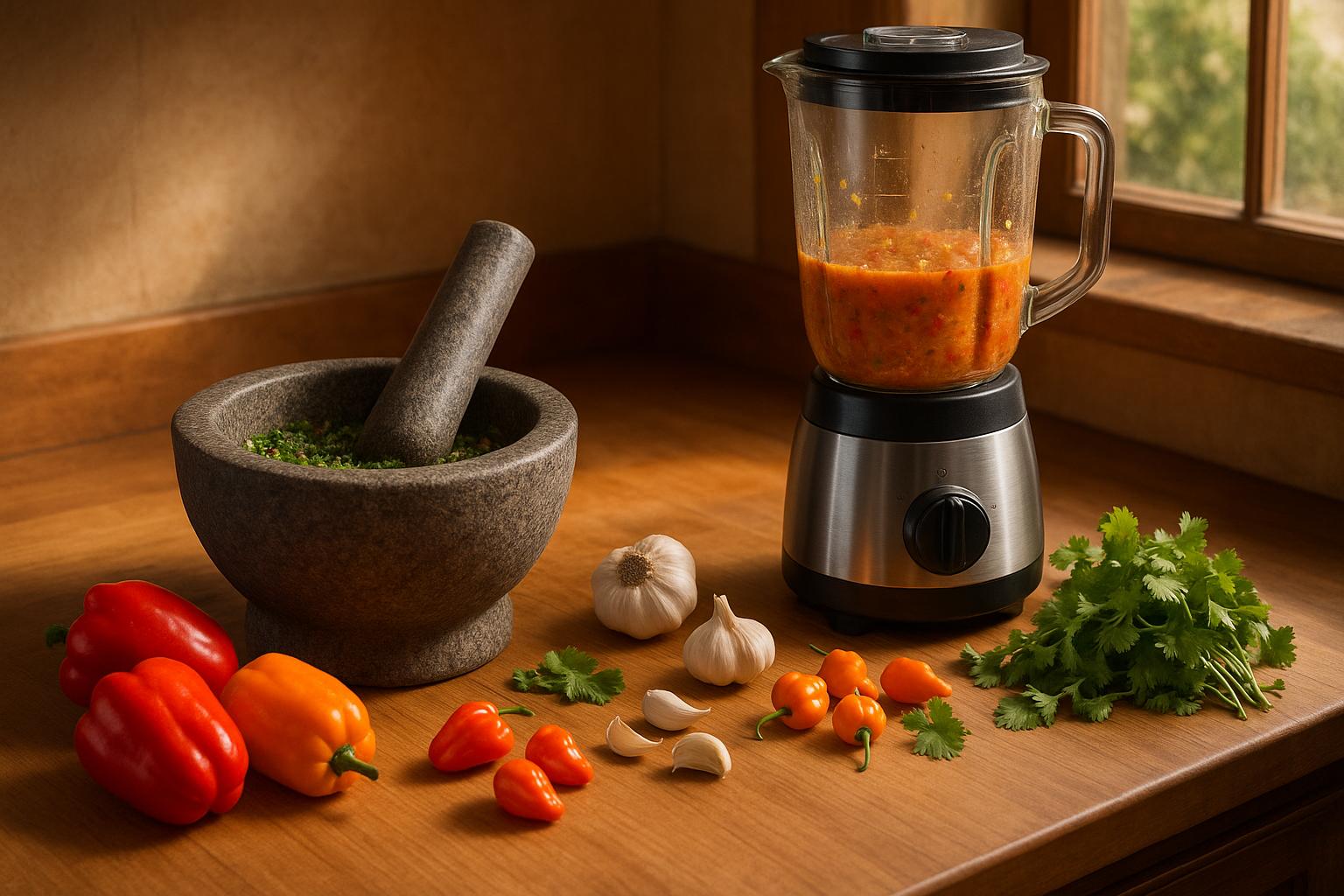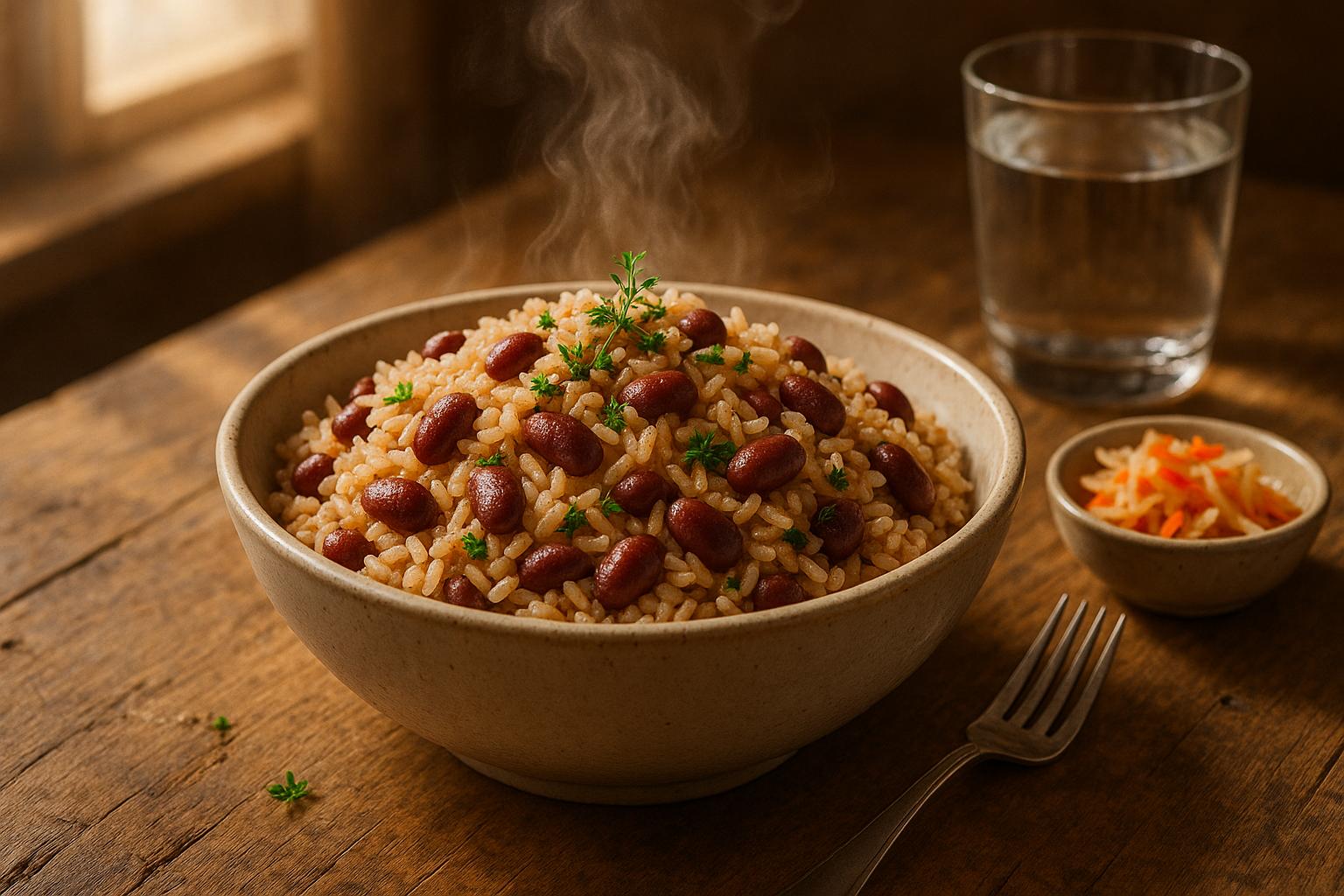Teaching kids to cook in Haitian homes is about more than just preparing meals. It’s a way to pass down identity, history, and family traditions. Parents involve children in cooking early, blending practical skills with storytelling and cultural values. The kitchen becomes a space for learning, bonding, and preserving heritage.
Key Points:
- Kids start by observing, then move to simple tasks like washing vegetables or seasoning food.
- Haitian kitchens use tools like the pilon (mortar and pestle) and chodyè (large pan) to prepare staple dishes.
- Ingredients like epis (a green seasoning blend), plantains, and mango are central to Haitian recipes.
- Cooking together helps children understand the meaning behind traditional dishes, like Soup Joumou, which symbolizes Haiti’s independence.
- Families living abroad adapt recipes to local ingredients while keeping core flavors intact.
Heart to Heart cooking with Haitian Mother & Son | Haitian Black Rice/Diri Djon Djon | Family Recipe
Basic Tools and Ingredients in Haitian Home Cooking
Getting familiar with the tools and ingredients that define Haitian cuisine is key to understanding its rich flavors and traditions. In Haitian households, children are introduced to these essentials early on, often through hands-on experiences with their parents.
Common Kitchen Tools and Their Uses
Haitian kitchens are home to a variety of traditional tools that have been passed down through generations. One of the most iconic is the pilon (mortar and pestle), used to grind ingredients for epis - a flavorful seasoning blend that’s the backbone of many dishes. Parents teach their children how to hold the pestle and use circular motions to crush ingredients effectively.
Another must-have is the chodyè, a large, shallow metal pan. It’s incredibly versatile and used for everything from frying to simmering. Children learn to recognize when the pan is properly heated and how to stir hearty dishes like rice and beans with a kiyè bwa (wooden spatula).
The graje (grater) is indispensable for grating coconut, a common ingredient in Haitian recipes. For many kids, mastering the graje is a rite of passage. Though tricky at first, it becomes a source of pride as they perfect the technique over time.
Other tools include the moulen (food grinder) for pureeing condiments, the pèz banann (plantain press) for flattening plantains, and the bak (fritter tray) for preparing fried treats like accra. While modern versions of these tools are available - such as plantain presses that can be purchased online for under $10 [3] - many Haitian families prefer the traditional versions for their authenticity and connection to heritage.
Key Ingredients Every Child Learns About
At the heart of Haitian cooking is epis, a vibrant seasoning blend made with thyme, parsley, garlic, onions, and green peppers [4]. This mixture is the foundation for countless dishes, and children are often involved in its preparation from a young age.
Staples like rice, beans, and corn are everyday essentials, while plantains - prepared either green or ripe - serve as both a vegetable and a starch. Mango, Haiti’s national fruit, is another vital ingredient, adding its distinct sweetness to a variety of dishes, both savory and sweet [5].
Young cooks also become familiar with fresh herbs and bold flavors, including scotch bonnet peppers, sour oranges, and leafy greens. The diverse influences of Creole, French, and West African cuisines are evident in the use of tomato paste, onions, and an array of spices to create the rich, layered flavors that define Haitian stews and sauces [5].
Learning Through Experience
The best way to understand these tools and ingredients is through practice. Haitian children often start by watching their parents at work - crushing garlic and scallions in a pilon or blending ingredients for the perfect epis. Over time, they begin to take on these tasks themselves, gaining confidence and a deeper appreciation for their culinary traditions [1].
Michaelle Barbor, a Haitian woman living in the U.S., captures this sentiment beautifully:
"When I use these tools, I'm not just cooking; I'm sharing the stories and traditions of my family and my people. It's my way of celebrating our history and inviting others to learn about the richness of Haitian cooking." [3]
These traditional tools are more than just practical - they’re a link to the past, helping each generation connect with their heritage. For more insights into Haitian cuisine and recipes, check out HaitianFoods.org. This hands-on learning forms the foundation for the step-by-step cooking lessons that follow.
How Parents Teach Cooking Step by Step
Haitian parents pass down the art of cooking through a thoughtful, step-by-step approach that blends tradition with practical skills. In this process, children gradually transition from passive observers to active participants in preparing family meals, ensuring both culinary techniques and cultural heritage are preserved.
Watching and Learning
The journey starts with observation. In Haitian households, children spend countless hours watching their parents and grandparents in the kitchen. They pick up on subtle details - like the sound of oil sizzling when it's ready or the way epis changes color as it cooks. These moments are more than just watching; they’re about absorbing the essence of cooking, learning the fine line between good and extraordinary. This foundation prepares them to take on small tasks as they grow older.
Starting with Simple Tasks
Once children have a sense of the basics, parents introduce them to simple, age-appropriate tasks. These might include washing vegetables, stirring a pot, or learning basic knife skills. These early responsibilities not only build confidence but also help children develop the core techniques they’ll need as they take on more complex roles in the kitchen [6][7].
Sharing Stories While Cooking
The kitchen isn’t just a place for cooking - it’s a space where stories and traditions come alive. As meals are prepared, parents share the history behind dishes, weaving cultural lessons into the process. For example, they might explain how Soup Joumou, a pumpkin soup enjoyed every January 1st, symbolizes Haiti’s independence in 1804. After years of oppression, this dish became a powerful emblem of freedom [8]. These stories give meals a deeper meaning, turning cooking into an act of preserving heritage. Through these shared moments, food becomes more than nourishment - it becomes a bridge to the past and a celebration of identity [2].
Practice Makes Perfect
Repetition is key to mastery. Children don’t just learn recipes once; they practice them over and over until the techniques become second nature. By regularly helping with staples like rice and beans, they refine their skills through hands-on experience. They learn to taste, adjust seasonings, and use traditional tools with ease. Over time, they become comfortable with the rhythms of cooking - stirring, flipping, timing - all while preserving the authentic methods and values that define Haitian cuisine. This repeated practice ensures that when they eventually cook on their own, they carry forward not just family recipes, but the heart and soul of their culinary tradition.
sbb-itb-80c33ff
Keeping Traditions Alive in New Places
For Haitian families living in the United States, preserving their culinary heritage often means adapting traditional recipes to fit their new environment. This process ensures that cherished traditions endure while evolving to meet the realities of a different setting. At the heart of this effort is the family kitchen - a space where learning, legacy, and culture come together.
Mixing Old and New Cooking Methods
Haitian parents have become skilled at blending their traditional recipes with ingredients and tools available in their new communities. The goal is to preserve the core flavors and techniques while making practical adjustments. Staples like Diri Kole (rice and beans) and Soup Joumou (pumpkin soup) are recreated using ingredients from local grocery stores, while harder-to-find items are sourced from ethnic or Caribbean markets. Parents also teach their children how to navigate American grocery stores, often relying on visual cues like packaging color and shape - a helpful strategy for those who may not be fluent in English [2].
Celebrating with Food Traditions
Food plays a central role in celebrating cultural heritage, especially during special occasions. Haitian families often host community gatherings featuring traditional dishes, giving children the opportunity to see their heritage honored and appreciated. These events foster a sense of belonging and pride, helping younger generations connect with their roots.
Building Pride Through Food
Learning to cook family recipes does more than teach a skill - it builds pride and transforms children into cultural ambassadors. Chef Widza Gustin, raised in America by Haitian parents, reflects on how these traditions shaped her identity:
"Even though we were born in America, we did not automatically take on American traditions. Instead we took all our Haitian heritage. We knew, from soups to nuts, everything that needs to be known about Haitian heritage and I appreciate my parents a lot for doing that." [1]
This pride isn’t confined to the family kitchen. Gustin emphasizes the importance of passing these culinary traditions down to future generations:
"I want to be able to show the next generation what I learned from my grandma and what I learned from my mom. I have a daughter who's half Haitian and half Trinidadian and I want to make sure that she fully understands the time that it takes to make Haitian food and what goes into our cuisine. I want to make sure that the next generation will be able to fully understand what I grew up on and make sure that they can continue to bring it down generation after generation." [1]
Through cooking, children not only learn the value of their heritage but also discover the power of food to bring people together and bridge cultural divides.
Conclusion: Building Family Legacy Through Cooking
Teaching Haitian cooking does more than just pass down recipes - it connects generations and keeps cultural heritage alive. When parents involve their children in preparing traditional dishes, they create bonds that tie family history to the present, ensuring these traditions thrive in the years to come.
Main Points to Remember
The kitchen serves as a space where cultural identity and cooking skills come together. Haitian cuisine reflects identity, resilience, and community. As Nadege Fleurimond, a cookbook author and restaurateur, puts it:
"It is the way we honor our history, celebrate life, and connect with each other. It's not just about food - it's about storytelling, pride, and preserving a legacy that blends African, Indigenous, French, and Caribbean influences." [9]
From observing to hands-on participation, children learn not only how to cook but also how food connects to memory and heritage. Traditional dishes become more than meals - they are links to ancestry, celebrations of history, and tributes to community. For Haitians, food embodies these connections, ensuring traditions remain vibrant and meaningful.
Continuing the Tradition
Preserving Haitian culinary traditions is an ongoing effort, one that spans generations. Recipes often carry deep personal and cultural significance, especially for families in the diaspora, acting as bridges to the homeland. By documenting recipes, recording cooking techniques, and involving children in holiday preparations, families strengthen these ties and pass them on.
The goal is to raise cultural ambassadors - individuals who confidently share their heritage with others. Each generation has the chance to add its own chapter to the family’s culinary story while maintaining its roots. Through teaching, learning, and adapting, Haitian families ensure their food traditions remain a vital part of their identity. This process, from watching to active participation, keeps Haitian culinary heritage alive in every home.
For more inspiration and resources on authentic Haitian recipes and cultural traditions, visit HaitianFoods.org.
FAQs
How do Haitian parents preserve authentic flavors when cooking traditional recipes abroad?
Haitian parents living overseas find creative ways to keep the flavors of home alive. They tweak traditional recipes to work with ingredients they can find locally, swapping herbs, spices, and produce for similar alternatives. Despite these adjustments, the bold and vibrant essence of Haitian cuisine remains at the heart of their cooking.
Recipes and cooking methods are often shared through word of mouth, keeping the tradition alive across generations. This hands-on way of passing down culinary knowledge allows families to stay connected to their roots, even while adapting to the resources available in their new surroundings.
What cultural values and traditions do Haitian parents share with their children while teaching them to cook?
Haitian parents see cooking as more than just a daily task - it's a way to instill values like family unity, resilience, and cultural pride in their children. Take Freedom Soup, or joumou, for instance. This pumpkin-based soup is prepared every New Year's Day to honor Haiti's independence and serves as a powerful symbol of freedom. In these moments, the kitchen becomes a space for storytelling, where elders pass down the history of the dishes and their deep significance to Haitian identity.
Grandmothers often take center stage in keeping these culinary traditions alive. They not only teach children how to cook but also emphasize the importance of using fresh ingredients and understanding the stories behind each recipe. Through these lessons, children gain a deeper appreciation for their heritage and strengthen their bonds with both their family and their community.
Why are traditional tools like the pilon and chodyè important for preserving Haitian cooking traditions?
Traditional tools like the pilon (mortar and pestle) and chodyè (cooking pot) are more than just kitchen essentials in Haitian cuisine - they’re a bridge to the past. These tools help preserve cooking traditions by keeping alive techniques like hand-grinding spices or slow-cooking meals, which bring out the bold and vibrant flavors Haitian food is known for.
For Haitian families, especially those living in the United States, using these tools goes beyond practicality. They offer a tangible connection to their heritage, reminding them of the history and culture infused into every dish. In many ways, these tools keep the spirit of Haitian cuisine alive, nurturing a sense of pride and identity within households and communities.


